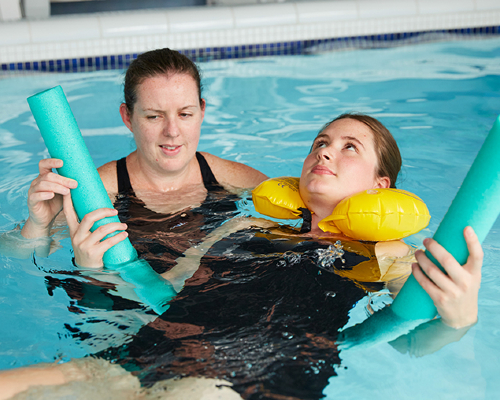A historical link
For centuries, humans have believed in the healing powers of warm water. Bath’s famous thermal spas, introduced during Roman times but later attracting Georgians in their droves, are a prime example. Bathers believed the naturally heated waters could cure anything from rheumatism to infertility.

What is osteoarthritis?
Osteoarthritis is a common condition that affects many of us as we get older and is caused by a gradual loss of articular cartilage in the joints. This causes a number of symptoms including:
- pain
- swelling
- joint stiffness
- reduced range of movement
- weak muscles
- joint deformity or instability
- difficulty in doing everyday tasks such as walking.
Several factors may increase the risk of developing osteoarthritis, such as increased age, being overweight, being inactive and previous injury or trauma.
Pain is usually worse in the morning, when standing up after having been sat down for long periods of time and when weight bearing (i.e. walking and climbing the stairs).
To help patients, there are a number of treatments available. This includes: physiotherapy, analgesia (pain relief), injection, and eventually for some, joint replacement surgery.
Joint replacement is the last treatment option available and it is always recommended that you try conservative treatment initially. This usually involves referral to a physiotherapist first, who can assess your joint and formulate a treatment plan for you.
The power of physiotherapy
Physiotherapy for osteoarthritis includes many elements, such as:
- education
- lifestyle modification advice
- manual therapy
- electrotherapy
- exercise.
Exercise should always be included in the treatment of osteoarthritis as it helps to mobilise stiff joints, increase cardiovascular fitness and strengthen the muscles surrounding the joint. By getting stronger there is less pressure exerted on the joints which can help to reduce your symptoms.
Exercise can take many forms, like 1:1 exercise sessions and group exercise classes.
Aquatic therapy: exercising in water
Meanwhile, aquatic therapy can be extremely beneficial for those who find exercising on land too painful or difficult.
This offers a number of benefits to your health and the specific symptoms of osteoarthritis, including:
- reducing pain
- reducing stiffness
- improving range of motion
- increasing muscle strength
- reducing swelling
- aiding relaxation.
The main difference between exercising in water compared to on land is the effect of buoyancy. Buoyancy is the up-thrust exerted on an object in water and is an opposing force of gravity, reducing the amount of weight bearing through the joints.
When standing in water at waist height you weigh approximately 50% of your body weight on land, which makes walking and exercising in the pool less painful. It can also assist with mobilising stiff joints and increasing your range of motion.
Buoyancy can be used to make exercises more challenging, using equipment such as floats that sit on the water’s surface. When pushing these down or moving them through the water, a resistance is generated that is similar to that of using weights on land.
Muscle strength can also be increased by utilising the drag resistance created when you move through water. This is what makes you move slower when walking in water compared to walking on land. Your therapist can increase the drag resistance and therefore make exercises harder by using external floats and increasing the speed of the exercise.
Many of the benefits of aquatic therapy occur simply from being immersed in water. When standing in water the hydrostatic pressure exerted on your body is around 10 times greater at the ankle than at the water’s surface. This difference in pressure increases circulation and can help to reduce swelling.
Releasing other pressures
Pain is a multidimensional experience and is not purely physical. It can be affected by other factors such as stress or anxiety. This is because the sympathetic nervous system responds to stress by engaging our fight or flight response, which can actually increase the level of pain that we feel.
Immersion in warm water suppresses activity of the sympathetic nervous system, reducing our experience of pain and aiding relaxation.
It is also suggested that the temperature and pressure of the water stimulates sensory nerve endings in the body that carry this information to our brain, blocking some of the pain signals and reducing the level of pain experienced.
Overall, aquatic therapy can make a significant difference to your pain, and help to improve your quality of life. It is an effective treatment at any stage of your journey with osteoarthritis whether you are new to exercise, have been living with pain for a long time, want to get stronger prior to joint replacement surgery, or are recovering after your operation.
Aquatic therapy at The London Clinic
Sessions last 30 minutes and the exercises are tailored to your specific joint and condition. You will be supervised by a physiotherapist who will guide you through your treatment and progress you at a pace that is appropriate for your specific needs.
Aquatic therapy
Further information
You can contact the Physiotherapy department directly on +44 020 7616 7651 or physio@thelondonclinic.co.uk if you would like more information on aquatic therapy.





